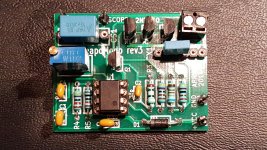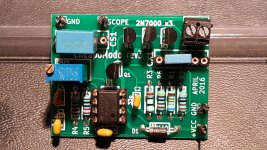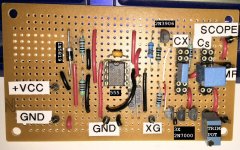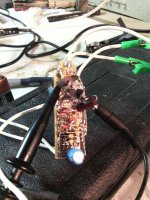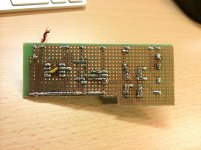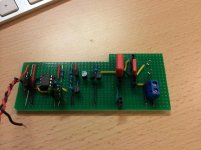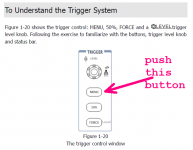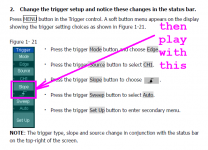The goal of Cheapomodo and Quasimodo is to snub out power transformer secondary ringing due to the insidious combination of (a) leakage inductance, combined with (b) rectifier diode switch-off. Since output transformers don't have rectifier diodes, I doubt that Cheapomodo or Quasimodo will do any good on them.
However, neither I nor anyone else on this site can prevent you from experimenting with your gear however you wish. If you optimize a "snubber" with Cheapomodo, and then connect it your output transformer, and if the result sounds better to you, it doesn't really matter what anyone else has to say about it. On the other hand if the modified output transformer catches fire and burns up your listening room, nobody is to blame except yourself.
However, neither I nor anyone else on this site can prevent you from experimenting with your gear however you wish. If you optimize a "snubber" with Cheapomodo, and then connect it your output transformer, and if the result sounds better to you, it doesn't really matter what anyone else has to say about it. On the other hand if the modified output transformer catches fire and burns up your listening room, nobody is to blame except yourself.
A snubber filter (I think) in AC use have sense, but with a DC rectifier is not negociable. It works very, very and again, very well.No noise and the resultant intermodulatión with audio signal can´t be.
An other thing: this "rectifier-noise" can "scape" throught the primary and via the power cable will contaminate the other audio elements.A disaster.The snubber and the help of any quick diodes avoid this.
The cheapomode is a device fantastic and very simple and userfull. Only with a two stupid caps and a lonely resistor we haven the solution.Cheap.
Mark, thank´s again.
An other thing: this "rectifier-noise" can "scape" throught the primary and via the power cable will contaminate the other audio elements.A disaster.The snubber and the help of any quick diodes avoid this.
The cheapomode is a device fantastic and very simple and userfull. Only with a two stupid caps and a lonely resistor we haven the solution.Cheap.
Mark, thank´s again.
Thanks, Mark, for a very useful design. Some questions:
1) I found the Cheapmodo when I was looking for a TH pcb for the Quasimodo. Is here a place to get pcb for the Quasimodo or the Cheapmodo?
2) Any measuring advantage on building one or the other?
3) I live in Brazil, so I would pay with Paypal and need the kit to be air-mailed to me. Shipping cost?
1) I found the Cheapmodo when I was looking for a TH pcb for the Quasimodo. Is here a place to get pcb for the Quasimodo or the Cheapmodo?
2) Any measuring advantage on building one or the other?
3) I live in Brazil, so I would pay with Paypal and need the kit to be air-mailed to me. Shipping cost?
The CAD files (in Gerber format) for Cheapomodo V.3 are attached to post #132 of this thread. The CAD files (in Gerber format) for Quasimodo are attached to post #1 of the Quasimodo thread. You can download those files yourself, and send them to a PCB maker in China. Choose one from the website pcbshopper.com. An example of its output is shown in the attached image.
Somebody is selling complete kits of Cheapomodo (PCB + all parts) in the Vendors' Bazaar of diyAudio. Use Advanced Search to find that thread. (Post #1 of this thread also has a link to it.) I have been told that somebody else is quietly selling complete kits of Quasimodo ThruHole, to find him you have to post a message in the Quasimodo thread saying "Want to buy a Quasimodo kit!! Send me a PM if you are selling!!" I don't know if he will respond or not.
Somebody is selling complete kits of Cheapomodo (PCB + all parts) in the Vendors' Bazaar of diyAudio. Use Advanced Search to find that thread. (Post #1 of this thread also has a link to it.) I have been told that somebody else is quietly selling complete kits of Quasimodo ThruHole, to find him you have to post a message in the Quasimodo thread saying "Want to buy a Quasimodo kit!! Send me a PM if you are selling!!" I don't know if he will respond or not.
Attachments
Thank you, Mark. Perhaps a pcb is not necessary?
It looks as if it could be easily assembled on a prototype board. Even for them I usually try the parts arrangement on a pcb design program, and it turns out quite well.
You didn't say which way to go: Quasimodo or Cheapmodo. Which advantage would the latter have over the former?
Can you measure individual snubbers for rectifier diodes?
It looks as if it could be easily assembled on a prototype board. Even for them I usually try the parts arrangement on a pcb design program, and it turns out quite well.
You didn't say which way to go: Quasimodo or Cheapmodo. Which advantage would the latter have over the former?
Can you measure individual snubbers for rectifier diodes?
Read post #1 of this thread very carefully. Read it two or three times. Then look at the photographs attached below. Then scan the thread and look at the scope pictures posted by people who built Cheapomodo.
_
_
Attachments
I had read post #1 carefully.
Now did it again, but it doesn't answer my question on what the Quasimodo might do better than the Cheapmodo.
Of course that building something from non-exotic parts it's much better. But what's the price, if any? A more precise result that would mean a better damping? Are there comparison photos with Quasimodo scope pictures?
Using one or the other, in the end you depend on the C and R values you may find or add up to achieve the result values, don't you?
Now did it again, but it doesn't answer my question on what the Quasimodo might do better than the Cheapmodo.
Of course that building something from non-exotic parts it's much better. But what's the price, if any? A more precise result that would mean a better damping? Are there comparison photos with Quasimodo scope pictures?
Using one or the other, in the end you depend on the C and R values you may find or add up to achieve the result values, don't you?
Digging around in my hobby room, I found a stack of about twenty of the OLD Cheapomodo rev.2 PCBs. These are exactly as shown in post #78 of this thread.
I am willing to give these away for free, to anyone who sends me a self-addressed & stamped envelope. Limit: 2 boards per diyAudio member. You are responsible for calculating and purchasing the correct postage to your address. Remember: I designed the PCB, I built the PCB, I'm giving away the PCB for free; you need to do your share of the work too.
Send me a PM telling me how many PCBs you want, and to get my mailing address in California USA. First come first served, I will eventually start replying "Sorry they are all gone".
Warning: rev2 is not the latest and greatest Cheapomodo PCB design. There has been a slight upgrade to rev3, see post #132 of this thread. In my opinion, rev3 might be ~ 5 percent better than rev2. If you want to send Gerber files off to a PCB fab to get some boards made, I suggest you send the rev3 Gerbers, you can download them for free from this thread. Also I am selling a few PCBs + kits of all parts, for Cheapomodo rev3, in the Vendors Bazaar. Use Search to find it.
I am willing to give these away for free, to anyone who sends me a self-addressed & stamped envelope. Limit: 2 boards per diyAudio member. You are responsible for calculating and purchasing the correct postage to your address. Remember: I designed the PCB, I built the PCB, I'm giving away the PCB for free; you need to do your share of the work too.
Send me a PM telling me how many PCBs you want, and to get my mailing address in California USA. First come first served, I will eventually start replying "Sorry they are all gone".
Warning: rev2 is not the latest and greatest Cheapomodo PCB design. There has been a slight upgrade to rev3, see post #132 of this thread. In my opinion, rev3 might be ~ 5 percent better than rev2. If you want to send Gerber files off to a PCB fab to get some boards made, I suggest you send the rev3 Gerbers, you can download them for free from this thread. Also I am selling a few PCBs + kits of all parts, for Cheapomodo rev3, in the Vendors Bazaar. Use Search to find it.
Thank you Mark
Cheapomodo rev.3 PCB and parts kit arrived yesterday. This is one cool product. I put it together last night and this morning, then did set-up and testing this afternoon...estimated construction and test times are pretty accurate. This has been a real learning experience, and lots of fun. I was able to get the following results at Rs=0Ω (pic 2) and Rs=7.1Ω (pic3) using Cx=.01u and Cs=.15u caps supplied.
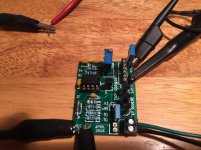
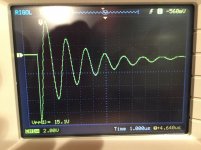
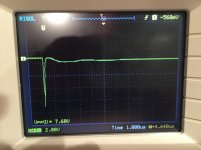
Cheapomodo rev.3 PCB and parts kit arrived yesterday. This is one cool product. I put it together last night and this morning, then did set-up and testing this afternoon...estimated construction and test times are pretty accurate. This has been a real learning experience, and lots of fun. I was able to get the following results at Rs=0Ω (pic 2) and Rs=7.1Ω (pic3) using Cx=.01u and Cs=.15u caps supplied.



Last edited:
Attaboy and congratulations, Kevin!
Looks like a very clean build and lovely waveforms on the scope. I see that you're triggering on the rising edge in picture 2; you may discover that with some "ill behaved" transformers, you get a cleaner display if you trigger on the falling edge.
You might want to purchase a couple of additional trimmer potentiometers, next time you place a parts order, just to give yourself finer granularity if and when needed. Maybe a 100 ohm and a 20 ohm pot would be nice things to have in your Cheapomodo project box.
Looks like a very clean build and lovely waveforms on the scope. I see that you're triggering on the rising edge in picture 2; you may discover that with some "ill behaved" transformers, you get a cleaner display if you trigger on the falling edge.
You might want to purchase a couple of additional trimmer potentiometers, next time you place a parts order, just to give yourself finer granularity if and when needed. Maybe a 100 ohm and a 20 ohm pot would be nice things to have in your Cheapomodo project box.
Thanks. You kinda lost me at the rising/falling edge thing. That's ok, it will force me to crack open the manual for my scope. Honestly, It's easier for me to learn visually and go "hands on". I'm actually looking at photos of waveforms in this thread and then turning dials and pushing buttons until I duplicate them. Reading is not my strong point. I've read thru post #51 of this thread, some of the Quasimodo thread, and of most of the Quasimodo note...that was enough to get me this far.
I will be ordering parts soon, so I'll get some trimmers.
I will be ordering parts soon, so I'll get some trimmers.
post152
It clearly shows why we should NOT add a lonely capacitor across the rectifier.
the ringing pic2 shows what we get when the transformer sees a step change in current demand and the rectifier or the transformer has a capacitor (0r of resistance) across instead of a snubber (R+C).Cheapomodo rev.3 PCB and parts kit arrived yesterday. This is one cool product. I put it together last night and this morning, then did set-up and testing this afternoon...estimated construction and test times are pretty accurate. This has been a real learning experience, and lots of fun. I was able to get the following results at Rs=0Ω (pic 2) and Rs=7.1Ω (pic3) using Cx=.01u and Cs=.15u caps supplied.
View attachment 599330 View attachment 599331 View attachment 599332
It clearly shows why we should NOT add a lonely capacitor across the rectifier.
Mark, do you have part numbers for the .01u and .15u caps that came with the kit. There are so many choices online. I would just like to use the same as you supplied.
Mark, do you have part numbers for the .01u and .15u caps that came with the kit. There are so many choices online. I would just like to use the same as you supplied.
Never mind, I got it.
The simple thing to do is (a) read Quasimodo design note page 7 paragraph 2; (b) purchase ten pieces each of Cx and Cs, with a voltage rating that's quite a bit larger than (1.5 x Vrms) voltage of your transformer secondary; (c) use these newly purchased capacitors, both for Cheapomodo testing AND in the final audio equipment.
Now you are very confident that the capacitors which worked well with your transformer in Cheapomodo, will also work well with your transformer in the final audio equipment -- because the exact same capacitors and the exact same transformer were used for both. You saw it perform well, with your own eyeballs, on your own oscilloscope. Sleep soundly.
Now you are very confident that the capacitors which worked well with your transformer in Cheapomodo, will also work well with your transformer in the final audio equipment -- because the exact same capacitors and the exact same transformer were used for both. You saw it perform well, with your own eyeballs, on your own oscilloscope. Sleep soundly.
Is it possible to verify that the actual snubber connected across the secondary is working by using the CheapoModo? The first attachment is the trace I get when inserting the actual parts I ordered in the CheapoModo and connecting to one secondary. The second attachment is the snubber installed in the transformer secondary. The third attachment is the trace I get with Cx, Cs, and Rs removed from CheapoModo, but having it connected to the transformer with snubber installed.
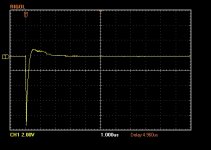
![IMG_1821[1].jpg IMG_1821[1].jpg](https://www.diyaudio.com/community/data/attachments/562/562111-e1555ec7a2b4f3aabf954e3cfac013f8.jpg?hash=4VVex6K086)
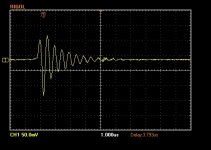

![IMG_1821[1].jpg IMG_1821[1].jpg](https://www.diyaudio.com/community/data/attachments/562/562111-e1555ec7a2b4f3aabf954e3cfac013f8.jpg?hash=4VVex6K086)

- Home
- Amplifiers
- Power Supplies
- CheapoModo: quick and dirty transformer snubber bellringer jig
